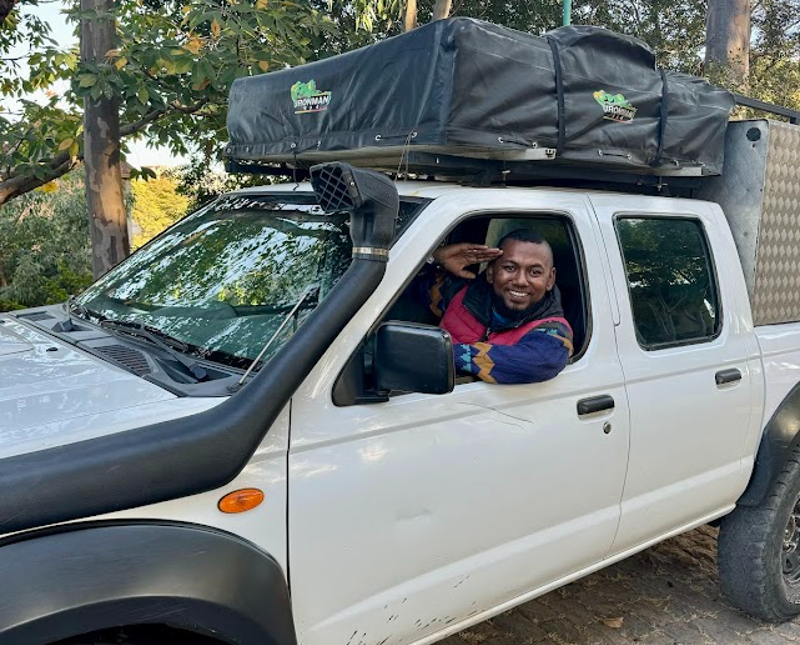Driving in Madagascar: Tips and information
Thinking about roadtripping Madagascar? Great choice! Madagascar offers many different terrains - from smooth asphalt to red earth and deep sandy tracks - and you'll have most roads all to yourself. On top of that, the Malagasy people are really friendly. Roadtrip-fun guaranteed!
This guide gives you clear tips and practical advice. Learn about renting a reliable 4x4, staying safe on the road, and what to expect while driving. You’ll also find answers to common questions, like road conditions and what gear you need.
Not keen to drive yourself? No worries! We explain how to hire a friendly, knowledgeable driver-guide to handle the roads for you.
Ready to start your adventure? Rent a safe, reliable 4x4 with us today and hit the road with confidence!
Is it safe to drive in Madagascar?
Our team at Roadtrip Africa has been exploring Madagascar by road for many years now. You are safe driving in Madagascar, and the experience is fun and rewarding as long as you follow the following rules and tips:
- Drive defensively, take it easy, and never rush. Some parts of the RN7 - and in particular the RN2 to Toamasina - may experience some congestion due to trucks. The road is narrow, winding, and full of potholes, so overtaking is dangerous. Instead of trying to overtake, it's better to take your time, not rush and join the traffic flow. If you do plan to overtake, keep a close eye on the truck in front of you. In Madagascar, trucks generally signal when it's fine to overtake them. If they don’t signal, then they probably haven't noticed you, so use your horn to warn them.
- Watch for speed bumps and potholes. Unmarked speed bumps are massive at times and can be difficult to spot due to overhanging trees. Potholes damage the car and can cause flat tyres.
- Purchase a local SIM card with internet access. There are three providers in Madagascar: Orange, Airtel and Telma, with Telma offering the best coverage. SIM cards are for sale at the airport, however, there is usually a long queue and it might take a while. SIM cards are also widely available in kiosks along the road and in shopping malls.
- Pay attention to signposts. When exiting a village, there is always a signpost indicating the distance to the next village and petrol station. Double-check this to make sure you don't run out of gas. To be on the safe side, we recommend you always fuel up when you leave a village.
- Always park in a secured area. Should you be spending the night at a local town hostel, make sure they have a secure car park available on their property.
- Avoid driving at night. In Madagascar, it gets dark around 6 PM. Potholes are difficult to see in the dark and approaching traffic uses blinding high beams. When you have a long travel day ahead, depart early (6-7 AM), to avoid ending up driving in dawn.
- Always carry cash, water and a charged mobile phone. Along the west coast, you can expect a few unofficial stop points where 'toll' is charged.
By following these tips, you can enjoy a safe and smooth driving experience in Madagascar.
Not comfortable driving yourself? No problem, just book a car with a knowledgeable driver-guide! Let them handle the roads while you sit back, relax, and soak in Madagascar's stunning scenery.

How are the road conditions for driving in Madagascar?
Be aware that asphalt roads in Madagascar are not well maintained. Some stretches might be washed away and you'll encounter many potholes, significantly reducing the distance you can cover in a day.
Madagascar's asphalt roads form a cross-shaped network. To create a bit of clarity:
- The RN6 and RN4 run from Antsiranana (Diego Suarez), at the northern tip of the island, to Antananarivo.
- From there, the RN6 continues as the well-known RN7, heading south to Tulear.
- Another asphalt road links Antananarivo to Tamatave in the east (RN2) and Morondava in the west (RN34 + RN35), providing connectivity across the diverse landscapes of Madagascar.
Let's dive in a bit deeper:
Driving the RN7 in Madagascar
- Antsirabe- Morondava
For the route to Miandrivazo, depart from the RN7 at Antsirabe onto the RN34. While Google Maps may suggest the RN35 through Malambandy, note that, as of October 2023, the broken bridge on the RN35 makes it impassable. No imminent repairs are scheduled. Don’t follow Google Maps.
- Ranomafana
Choose the straightforward route via the RN7 to Ranomafana, branching off at Alakamisy onto the RN45. An alternative, less advisable route is via Ambohimasoa, joining the RN25. However, due to poor road conditions on the RN25, the longer duration makes it less recommended.
- Anakao by boat
Travel to Anakao by boat from Tulear. Please notify us in advance for secure parking, and a designated driver can pick you up from your hotel.
- Anakao by car
Though the ferry from St. Augustin is no longer operational, Anakao remains accessible by car. Take the RN10 to Betioky, then head west. Along this route, don't forget to visit Lac Tsimanampetsotsa, a beautiful lake with flamingos, hardly ever visited by tourists.
Driving the west coast of Madagascar
- Tulear-Morombe
Enjoy the scenic route along the Mozambican channel and the Mikea Forest without the need for sand plates or tyre deflation. While the road does have some sandy stretches, the journey is breathtaking.
- Morondava to Manja
Encounter occasional roadblocks in the Morondava, Belo, and Manja areas, set up by villagers managing and benefiting from passing vehicles. The actual fee you pay depends on your negotiation skills, but always remember to remain friendly. It's essential to remember that you are visiting a region with a high poverty level, where it's hard for people to make a living. Experience a reasonably maintained road for a smooth one-day journey from Manja to Morondava.
- Morombe-Manja
Be aware that the road between Morombe and Bevoay is in a bad state and has many potholes. Cross the Mangoky River via ferry or dam during bridge construction. Beyond the river, enjoy a well-maintained road to Manja.
- Belo sur Mer
Visiting Belo sur Mer with one of our rental cars is only allowed when travelling with a driver-guide or pisteur. To reach Belo sur Mer you have to cross a salt plain where you'll quickly get stuck if you don't know which track to follow. For those without a pisteur, skip Belo sur Mer or opt for a boat ride from Morondava through Entremer, the ideal base in Belo sur Mer.
- Tsingy de Bemaraha
The road from Morondava to Bekopaka, the entrance village to the Tsingy de Bemaraha National Park, is an easy off-road track, but it's a long journey (8-10 hours). Calculate a full travel day getting to and from.
Driving in Northern Madagascar
- RN4
While generally in reasonable condition, the RN4 may present unexpected potholes.
- RN6
Prepare for a bad road from Ambondramamy to Ambanja, spanning 2 days with stretches limiting speeds to 30 km/h. Beyond Ambanja, the road is repaired and well-maintained.
- Nosy Be
How to get to Nosy Be when travelling overland? Ankify is a harbour and small village in the northwest of Madagascar. From Ankify, ferries service Nosy Komba and Nosy Be (Hell Ville harbour). They run multiple times a day and leave when full. You can also charter a smaller passenger boat. Contact the lodge where you're staying in Nosy Komba to assist.
Driving in Antananarivo
The capital of Madagascar is a hectic and confusing town due to many traffic jams, numerous one-way streets and a lack of road signs. On top of that, the city has implemented a complicated parking payment system and high fines for unauthorized street parking. We therefore strongly recommend exploring Antananarivo by taxi. At Roadtrip Africa, we're also happy to arrange a private driver for you for €20, payable directly to the driver. Please note that we do not offer car deliveries or pickups in Antananarivo, and parking fees are the responsibility of the hirer.
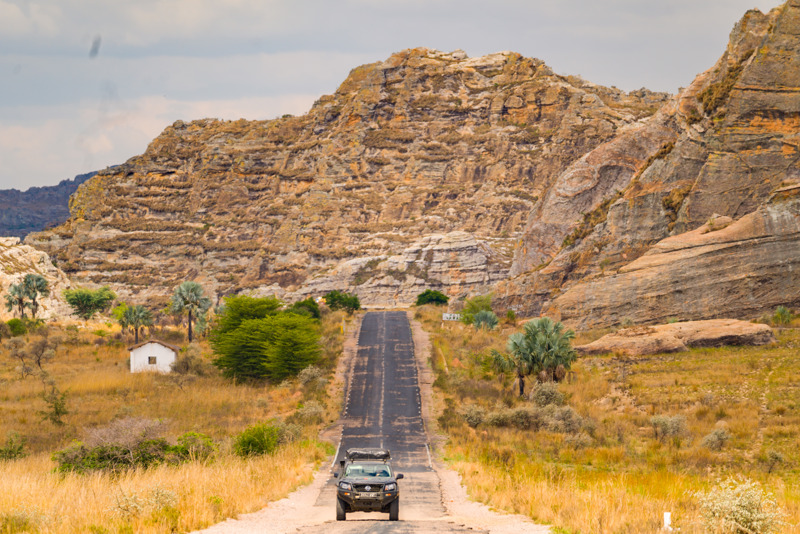
Off-road driving in Madagascar
The West Coast of Madagascar - included in our Grand Circuit itinerary - contains the country's most challenging route and requires some off-road driving. When renting your car through us, we allow you to explore the West Coast by yourself. We do, however, want you to honestly assess if this is something you feel comfortable with. Driving on the west coast of Madagascar is only suitable for confident drivers, who don't panic when they might get lost a little or drive in a remote area.
Don't feel comfortable driving in western Madagascar by yourself? For less confident drivers, we strongly recommend renting a ''pisteur'' (navigator). He/she helps you navigate your vehicle, particularly when crossing rivers during high tide. The benefits of a pisteur:
- They know the region by heart
- You'll have the experience of driving yourself,your pisteur only gives instructions
- They will particularly guide you through the 'hard' part between Tulear and Morondava
When you book the Grand Circuit as a Tour with set route and prebooked accommodation, the services of the pisteur are included in the package.
Otherwise, renting your car with pisteur is easily done when filling out our car rental booking form.
Prefer to hand over the driving completely? Then rent a local driver-guide instead - allowing you to sit back, relax, and enjoy the ride!
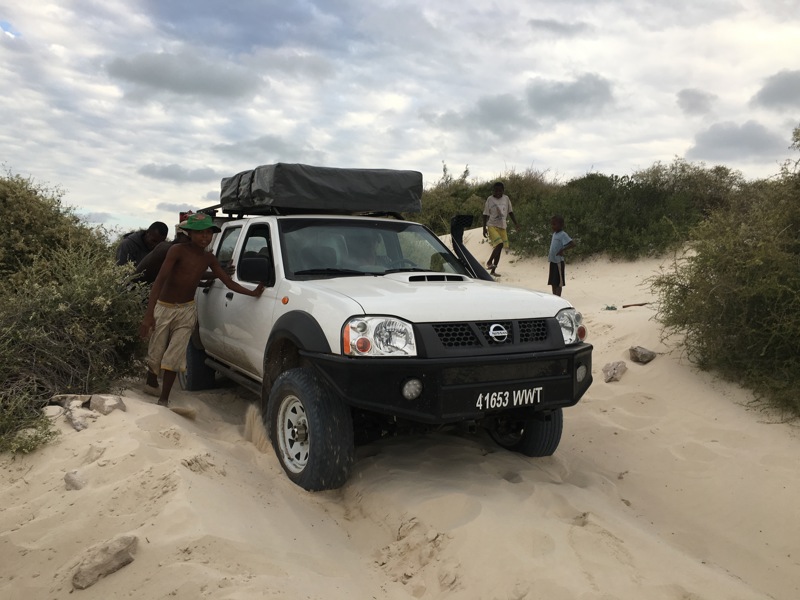
Do I need an international driving license in Madagascar?
Yes, you need an international driving license in Madagascar when driving a rental car. Apply for your international license in your country of residence.
At what side of the road should I drive in Madagascar?
Right. Driving in Madagascar is done on the right side of the road.
Which Telecom providor do I use in Madagascar?
Before you start your roadtrip, make sure you get a SIM card and load it with sufficient data for internet and phone calls. Madagascar has three mobile network providers supporting the 4G network: Orange, Airtel and Telma. Telma has the best coverage.
SIM cards are for sale at the airport. However, there is usually a long queue and it might take a while. It is sometimes quicker and easier to get your SIM card in a kiosk along the road or at a shopping mall.
Have you rented your car through us? Then our colleagues, who meet you at the airport, can also explain to you where to buy a SIM card.
How does it work with navigation in Madagascar?
All our rental vehicles in Madagascar come with a detailed roadmap of the country.
Besides Google Maps, we strongly recommend that you install Maps.me on your smartphone before travelling to Madagascar. It's a free app that allows you to use GPS offline. We also recommend downloading the app iOverlander, which includes almost every campsite in the country.
For more information on actual driving distances in Madagascar, consult our time & distance table. Madagascar is not the kind of destination where creating a route is done simply by checking out Google Maps. What seems like a road might no longer exist, and ''shortcuts'' are never possible. You might end up in a situation like our friend in the below picture. ;)
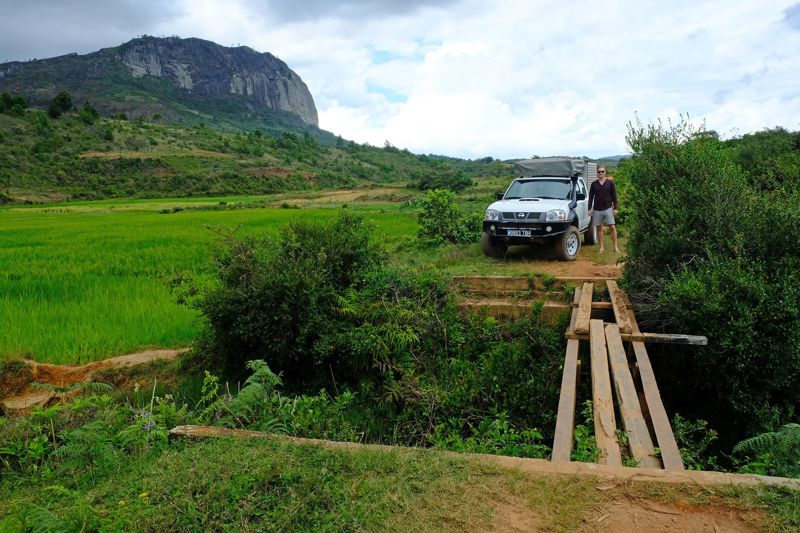
How to deal with traffic police in Madagascar?
There is not a lot of traffic police in Madagascar. If you do spot them, they are most likely asleep or will be smiling and waving at you. Traffic police mostly focus on trucks instead.
Advice that comes in handy when dealing with any kind of government official is to remain patient and friendly. Greet them politely in Malagasy or French, make a joke and you have a new friend. They will want to see your driver's license and ID, check car papers and make sure that the vehicle is insured. Of course, that will all have been taken care of if you rent a car from Roadtrip Africa.
What happens if I get a breakdown or accident while driving in Madagascar?
Our rental fleet in Madagascar is bought new between 2020 and 2025 and is well-maintained. Breakdowns are therefore very rare. Still, unexpected issues may occur when driving on challenging roads in Madagascar. Here’s what you need to know:
Why breakdowns happen
Breakdowns can occur due to:
- The condition of the car
- Road conditions (potholes, speed bumps, mud, dust)
- Driving behaviour (speeding, fatigue)
- Bad luck
Although we can only affect the first of these events, we will help you to the best of our abilities, regardless of the reason for your breakdown. Our team is very experienced in troubleshooting along the way, but keep in mind that cooperation, flexibility, and patience on your end are key to resolving issues quickly, too.
Preventing issues
In our ten years of experience, we learned that many breakdowns on self-drive trips are caused by driving behaviour - often infused by jam-packed itineraries leading to long driving days and speeding or fatigue. Hence, our most important piece of advice: make sure your travel plan is not too ambitious. Prevention is better than troubleshooting.
What we do to help
-
Minor issues: We’ll connect you with our network of bush mechanics for quick, on-the-spot fixes.
-
Major issues: If the car cannot be repaired within 24 hours, we’ll provide a replacement vehicle so you can continue your trip.
-
Accidents or breakdowns: Contact our Madagascar office immediately. We’re available 24/7 to guide and assist you.
Unfortunately, workshops in Madagascar are notorious for defrauding. We know how to handle this, and therefore ask you to always contact our Madagascar office first when something happens, whether it's a mechanical issue or an accident. Our phone number is available 24 hours a day.
Where can I rent a car in Madagascar?
Excited to start your road trip in Madagascar? At Roadtrip Africa, we’re here to help you find the perfect vehicle for your adventure.
Why choose Roadtrip Africa?
-
Reliable 4WD fleet: Our vehicles are sturdy, widely trusted, and ideal for Madagascar's roads.
-
No third parties: We own all our cars, ensuring top quality, 24/7 roadside assistance and no fuss.
-
Years of experience: We are adventure travellers ourselves, and have a knowledgeable, local team on the ground to guide you.
Ready to go?
Book your 4WD car today and get ready to explore Madagascar at your own pace!

Is insurance included with my rental car in Madagascar?
Yes, our car rental in Kenya includes insurance. This covers damage from accidents or fire and includes third-party liability in case of a car accident.
Choose your insurance coverage
Our standard insurance has a maximum deductible of €1500. This means that in the event of damage for which liability is waived, the first €1500 is at your own expense (also called the excess fee).
When you add Comprehensive Collision Damage Waiver (€10/ day), the maximum deductible is lowered to € 250.
When you choose Zero Excess (€20/ day), the insurance also covers damage to tyres, screens and undercarriage, and the excess fee is lowered to zero.
What’s not covered?
- Personal injury or loss of possessions - these fall under your personal medical or travel insurance.
- Damage caused by:
-
-
Driving over the speed limit
-
Single-vehicle rollovers (considered reckless driving)
-
Neglecting proper care or maintenance of the vehicle
-
Driving under the influence of alcohol or drugs
-
Using the car on restricted roads or in prohibited areas
Our full terms & conditions are included in the car rental agreement. You can also consult them here.
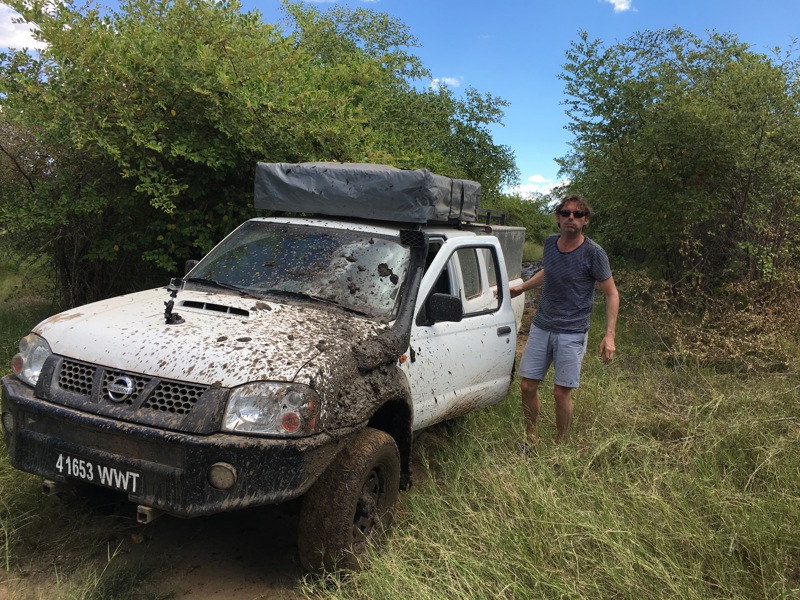
Where can I rent a driver in Madagascar?
If you prefer not to drive yourself, hiring a local driver-guide is a fantastic option. At Roadtrip Africa, we can arrange a knowledgeable and friendly driver to accompany you on your road trip.
Why hire a driver-guide?
-
Local expertise: Your driver knows Madagascar's roads, culture, and hidden gems, making your trip stress-free and enriching.
-
Flexible itinerary: You stay in control of your holiday plans while your driver handles the logistics and driving.
-
Affordable rates: A driver costs just €30/day, giving you peace of mind and extra comfort.
Hiring a driver is simple - just let us know during your booking, and we’ll take care of the rest!
